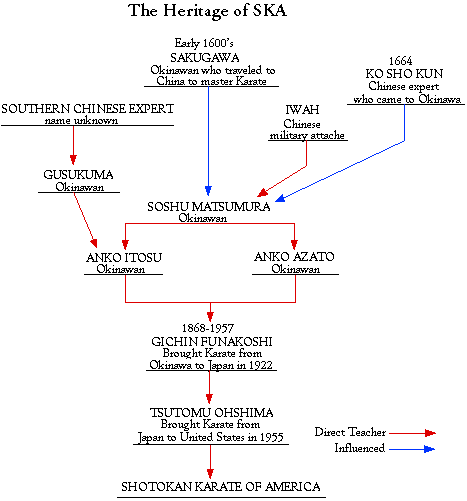-- Gichin Funakoshi
But Karate training soon teaches that real strength is facing oneself strictly with severe eyes. This is the first condition of martial arts training. Therefore, everyone in SKA must be strong inwardly but quite gentle to others.
As we train together, each contributing to a good atmosphere, let's try to bring out that serious, strong mentality from deep inside."
-- Tsutomu Ohshima, Shihan
What is karate?
Karate may be defined as a weaponless means of defense. It consists of
dynamic offensive and defensive techniques using all parts of the body to their
maximum advantage.
Karate practice
Karate practice is divided into three categories:
As the student progresses technically, he progresses physically and his practice demands greater stamina. At this stage he involves himself with the more intricate and difficult katas and more dynamic forms of kumite.
As the student approaches black belt level, technique, stamina, speed and coordination become natural to him as a result of strong practice. It is at this stage that the serious student discovers that he has only just begun his study of karate. The object of true karate practice is perfection of oneself through the perfection of the art.
Karate as self-defense
Karate as self-defense is one of the most dynamic of all the martial
arts. The trained karateist is able to coordinate his mind and body
perfectly, thereby allowing him to unleash tremendous physical power at will.
Therefore, it is not the possession of great physical strength that makes
a strong karateist; rather it is the ability to coordinate mind over body.
Upon developing this ability, even the smallest person finds that he has
within himself the power to deliver a devastating blow to any would-be
attacker.
The values of karate
The values of karate to modern man are numerous. In our everyday lives
we often forget the value of exercise to both our physical and mental health.
The practice of karate tones the body, develops coordination, quickens
reflexes, and builds stamina.
Also, the serious practice of karate develops composure, a clearer thought process, deeper insight into one's mental capabilities, and more self-confidence. In this, karate is not an end, but a means to an end. It is an activity in which advancing age is not a hindrance. Rather it encourages proficiency in the keen coordination of mind and body.
China History
Although the ancient origins of karate are extremely vague, we do know that
about 1400 years ago while teaching at the Shaolin Temple in China, Daruma
Daishi used techniques developed into fighting forms known as Shaolin Boxing.
Okinawa
In the 16th Century, Shaolin Boxing found its way to Okinawa from China. It
combined with native Okinawan techniques to develop into several Okinawan
styles.
Japan - Master Funakoshi
In 1922, having mastered two major styles in Okinawa, Master Gichin Funakoshi,
then President of the Okinawa association of the Spirit of Martial Arts, was
chosen to demonstrate karate at the first National Athletic Exhibition in
Tokyo. This led to the introduction of the ancient martial art to the rest of
Japan. At the urging of friends and officials, he remained in Tokyo to teach.
U.S.A. - Tsutomu Ohshima
Tsutomu Ohshima was one of Master Funakoshi's last direct pupils (1948 - 1953)
studying under him while attending Waseda University in Tokyo, Japan. In 1955,
Mr. Ohshima came to the United States and was the first man to teach Karate in
this country. That same year he organized the Southern California Karate
Association, which has grown over the years to become a nationwide organization,
Shotokan Karate of America.
Shotokan Karate of America is now, as it was then, a non-profit organization that tries to maintain a high level of non-commercialism. Shotokan Karate of America, Inc. is devoted to teaching Karate on its highest level, as a martial art. To this end, Shotokan Karate of America, Inc. conducts lectures, seminars and regularly scheduled intensive training sessions for all students, as well as a continous training program for advanced students and instructors. Those seriously interested in the study of a martial art are welcome to join us.
